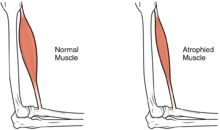
Back ضمور اللحم Arabic Sarkopeniya Azerbaijani Sarkopenija BS Sarcopènia Catalan Sarkopenie German Sarcopenia Spanish Sarkopeenia Estonian کمماهیچگی Persian Sarkopenia Finnish Sarcopénie French
| Sarcopenia | |
|---|---|
 | |
| Difference between a normal muscle and an atrophied muscle | |
| Specialty | Geriatrics Rheumatology |
Sarcopenia (ICD-10-CM code M62.84[1]) is a type of muscle loss that occurs with aging and/or immobility. It is characterized by the degenerative loss of skeletal muscle mass, quality, and strength. The rate of muscle loss is dependent on exercise level, co-morbidities, nutrition and other factors. The muscle loss is related to changes in muscle synthesis signalling pathways. It is distinct from cachexia, in which muscle is degraded through cytokine-mediated degradation, although the two conditions may co-exist. Sarcopenia is considered a component of frailty syndrome.[2] Sarcopenia can lead to reduced quality of life, falls, fracture, and disability.[3][4]
Sarcopenia is a factor in changing body composition. When associated with aging populations, certain muscle regions are expected to be affected first, specifically the anterior thigh and abdominal muscles.[3][5] In population studies, body mass index (BMI) is seen to decrease in aging populations while bioelectrical impedance analysis (BIA) shows body fat proportion rising.[6]
A new sarcopenia related condition is the Steatosarcopenia proposed by the Steatosarcopenia & Sarcopenia Brazilian Study Group. This condition is characterized by the loss of mass or skeletal muscle strength and performance associated with the excessive deposition of ectopic reserve fat in muscle tissue, in the same individual, not necessarily related to [7]excess fat total body mass. Steatosarcopenia: A New Terminology for Clinical Conditions Related to Body Composition Classification.
- ^ Anker SD, Morley JE, von Haehling S (17 October 2016). "Welcome to the ICD-10 code for sarcopenia". Journal of Cachexia, Sarcopenia and Muscle. 7 (5): 512–514. doi:10.1002/jcsm.12147. ISSN 2190-5991. PMC 5114626. PMID 27891296.
- ^ Peterson SJ, Mozer M (February 2017). "Differentiating Sarcopenia and Cachexia Among Patients With Cancer". Nutrition in Clinical Practice. 32 (1): 30–39. doi:10.1177/0884533616680354. PMID 28124947. S2CID 206555460.
- ^ a b Ata AM, Kara M, Kaymak B, Özçakar L (October 2020). "Sarcopenia Is Not "Love": You Have to Look Where You Lost it!". American Journal of Physical Medicine & Rehabilitation. 99 (10): e119 – e120. doi:10.1097/PHM.0000000000001391. PMID 32084033. S2CID 211245329.
- ^ Beaudart C, Zaaria M, Pasleau F, Reginster JY, Bruyère O (2017). "Health Outcomes of Sarcopenia: A Systematic Review and Meta-Analysis". PLOS ONE. 12 (1): e0169548. Bibcode:2017PLoSO..1269548B. doi:10.1371/journal.pone.0169548. PMC 5240970. PMID 28095426.
- ^ Ata AM, Kara M, Kaymak B, Gürçay E, Çakır B, Ünlü H, et al. (2019). "Regional and total muscle mass, muscle strength and physical performance: The potential use of ultrasound imaging for sarcopenia". Archives of Gerontology and Geriatrics. 83: 55–60. doi:10.1016/j.archger.2019.03.014. PMID 30953961. S2CID 96463073.
- ^ Ranasinghe C, Gamage P, Katulanda P, Andraweera N, Thilakarathne S, Tharanga P (September 2013). "Relationship between Body Mass Index (BMI) and body fat percentage, estimated by bioelectrical impedance, in a group of Sri Lankan adults: a cross sectional study". BMC Public Health. 13: 797. doi:10.1186/1471-2458-13-797. PMC 3766672. PMID 24004464.
- ^ Michels G, Mattos Rosa G, Renke G, Starling-Soares B (November 2024). "Steatosarcopenia: A New Terminology for Clinical Conditions Related to Body Composition Classification". Life. 14 (11): 1383. doi:10.3390/life14111383. ISSN 2075-1729. PMC 11595699.